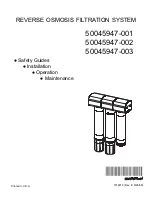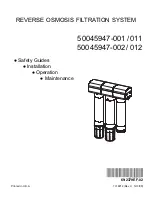
4
NOTICE
Water known to have heavy loads of dirt and debris may
require pre-filtration prior to OneFlow.
NOTICE
Spotting May Occur on External
Plumbing Surfaces
OneFlow media systems perform best in single pass potable
water applications with NO additional chemical additives.
Depending on hardness, soft scale spotting may occur. Soft
scale spots in most cases can be easily wiped down with a
damp cloth and will not form hard scale deposits. A Point of
Use (POU) Water Softener should be used on mandatory
spot-free applications (e.g. glass stemware, dishware).
Feed Water Chemistry Requirements and
Operating Conditions
pH
6.5-8.5
Hardness (maximum)
30 grains (513 ppm CaCO3)*
Water Pressure
15psi to 100psi (1.03 bar to 6.9 bar)
Water Temperature
40°F to 100°F (5°C to 38°C)
Free Chlorine
<2 ppm
Iron (maximum)
0.3 ppm**
Manganese (maximum)
0.05 ppm**
Copper (maximum)
1.3 ppm***
Oil & H2S
Must be Removed Prior to OneFlow
Total Phosphastes
< 3.0 ppm
Silica (maximum)
20 ppm †
TDS
<1500 mg/L ††
Min/Max Ambient
Temperature
34°F to 120°F (1°C to 48°C)
Maximum Humidity
75%
Power Supply Input
Voltage/Frequency
115 VAC / 60Hz
Power Supply Output
Voltage
12 VDC
Power Supply Output
Current
.4 amps
Maximum Altitude
2,000 meters above sea level
Wi-Fi Signal Type
2.4 GHz
NOTICE
Not for use on closed loop systems.
* Systems using OneFlow technology are effective at controlling
limescale formation inside the plumbing system at influent hardness
levels up to 75 grains per gallon (1282 ppm) as calcium carbonate.
Due to variances in water chemistry, 30 grains per gallon is a
recommended hardness maximum due to potential aesthetic
issues related to soft scale residue formation outside of the plumbing
system. Testing should be performed to determine proper application
where hardness levels exceed 30 grains per gallon.
**Just as with conventional water softening media, OneFlow
media needs to be protected from excess levels of certain metals
that can easily coat the active surface, reducing its effectiveness
over time. Public water supplies rarely, if ever, present a prob-
lem, but if the water supply is from a private well, confirm
that the levels of iron (Fe) and manganese (Mn) are less than
0.3 ppm and 0.05 ppm, respectively.
WARNING
!
***Pursuant to the EPA drinking water standards, the copper
concentration permitted is up to 1.3 ppm. Typically origi-
nating from new copper plumbing, high levels of copper
can foul OneFlow media. New Copper lines need to be
passivated for a minimum of 4 weeks before placing unit
into service. For applications with copper concentration
greater than 1.3 ppm, please consult Watts Water Quality
Technical Service. To further minimize any problem with
excess copper, avoid applying excessive flux on the inner
surfaces of the pipe and use a low-corrosivity water
soluble flux listed under the ASTM B813 standard.
† OneFlow media does not reduce silica scaling. While silica
tends to have a less significant effect on scale formation than
other minerals, it can act as a binder that makes water spots
and scale residue outside the plumbing system difficult to
remove. This 20 ppm limitation is for aesthetic purposes.
†† All other contaminants must meet the requirements of the
USEPA Safe Drinking Water Act. Specific Mineral and Metal
MCL’s, identified in Watts published Feed Water Chemistry
Requirements, supersedes the USEPA SDWA.





































